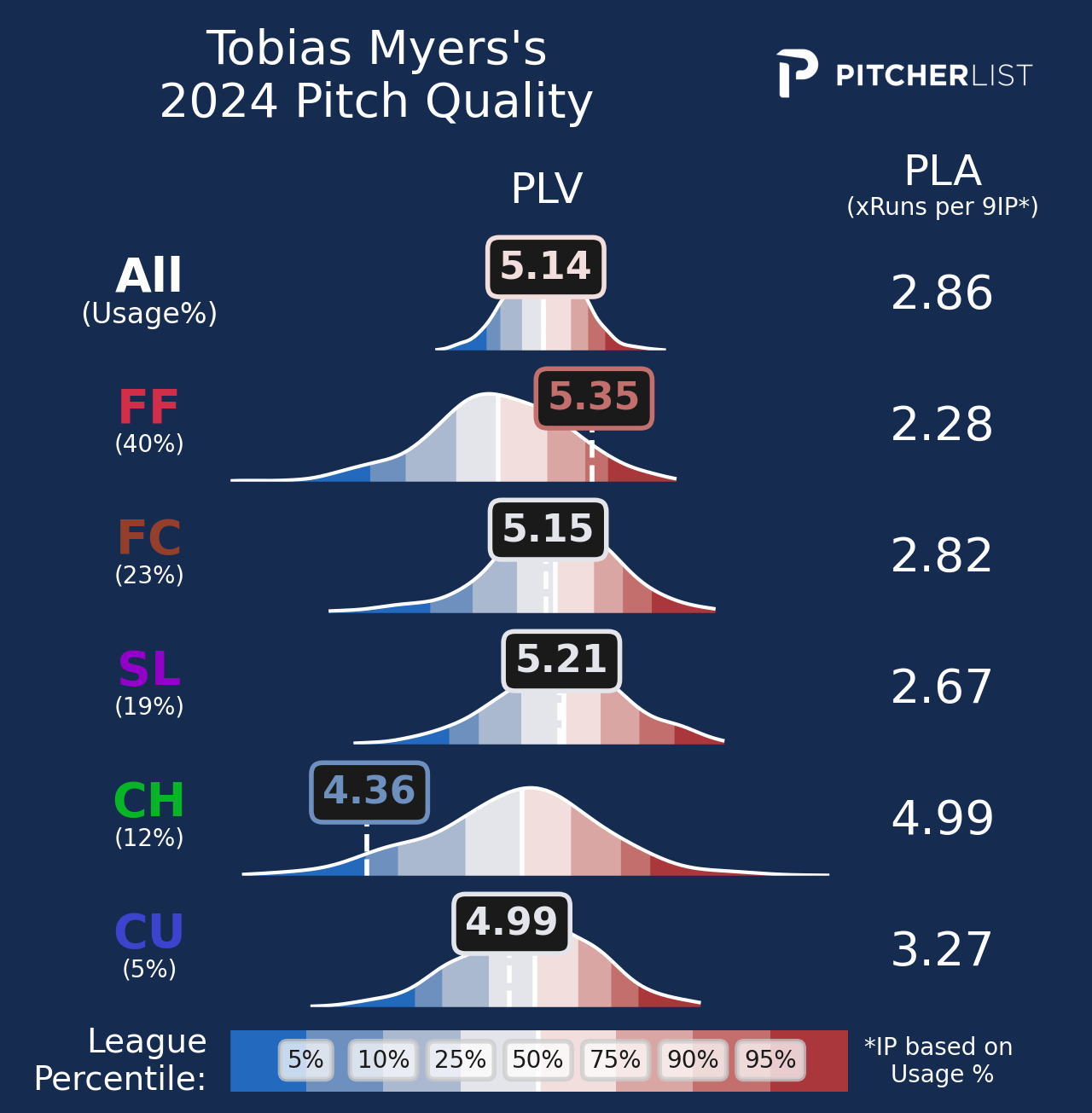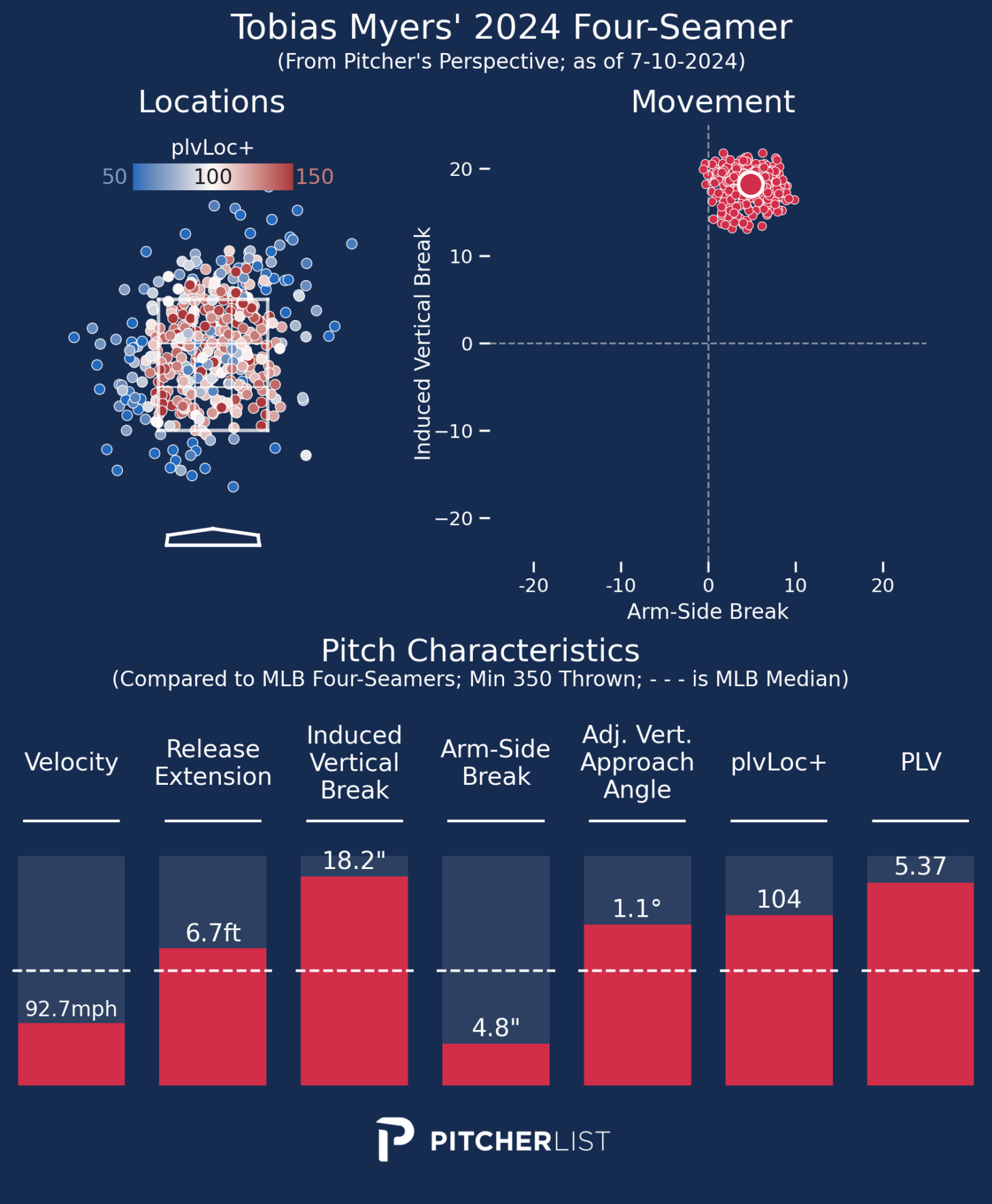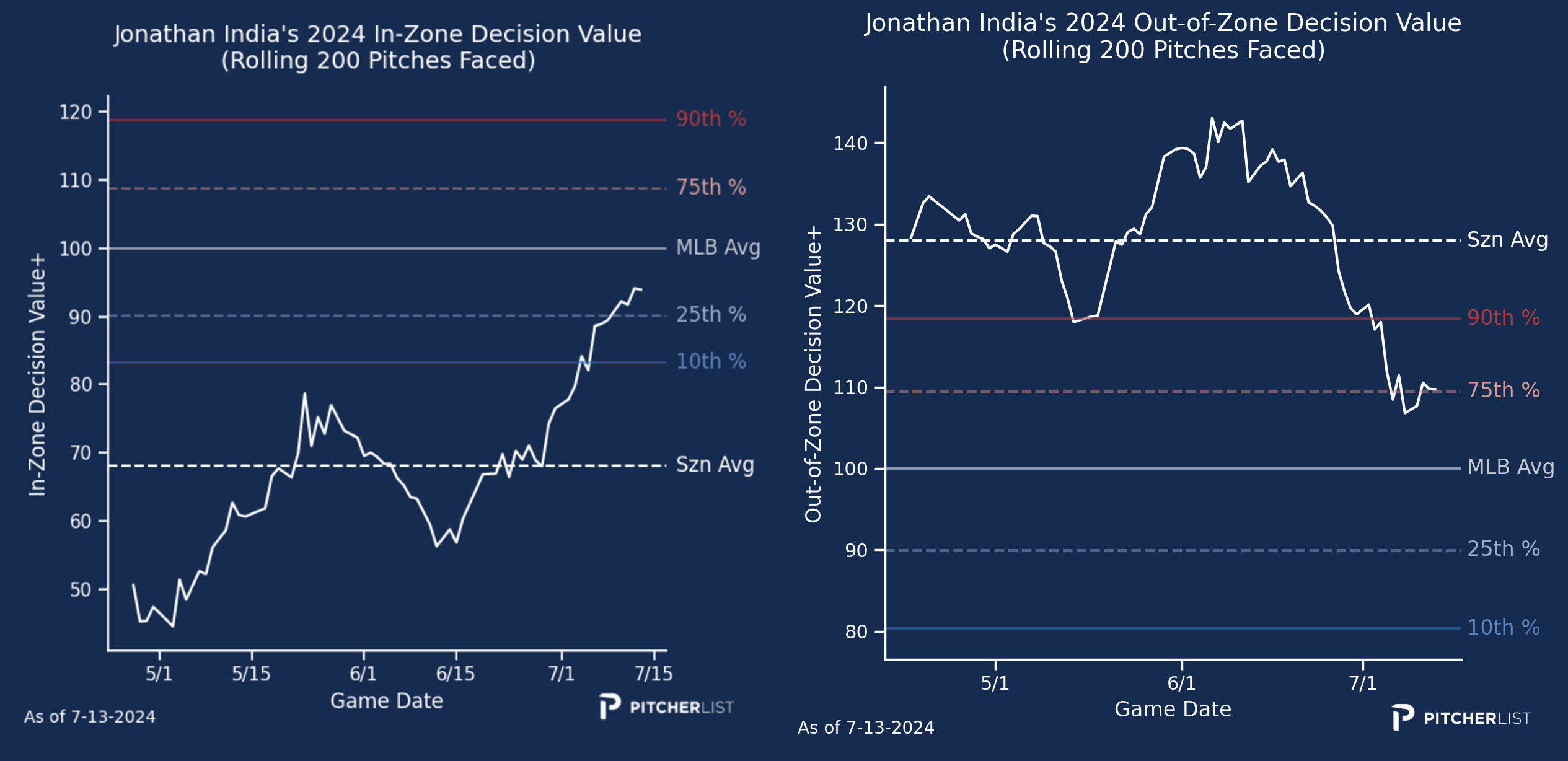The All-Star break has arrived, which means we’re officially entering the stretch run as the fantasy playoffs come into view. Your league’s trade deadline is likely just a few weeks away (check if you don’t know!), so there isn’t much time left to make big moves to address your squad’s needs before you’re left with only waiver wire additions the rest of the way. Thankfully, with a keen eye and a bit of research, we can still uncover some meaningful contributors on the waiver wire, and that’s what we’re hoping to do right here. Let’s dive into three of the game’s hottest players to see if their success is sustainable the rest of the way.
Spencer Horwitz, 1B/2B, Toronto Blue Jays
Since making his debut on June 8th, Horwitz has done nothing but hit. The lefty-swinging infielder has slashed .319/.425/.489 with four home runs over his first 113 plate appearances. His .398 wOBA and 162 wRC+ are both top-25 marks among all hitters over that period, so it’s pretty surprising to see him with such small roster rates. He’s only on 21% and 7% of fantasy teams on Yahoo! and ESPN, respectively.
Horwitz hasn’t just been getting good results, but process-wise, things look strong as well. His 13.4% strikeout rate and 12.5% walk rate are both 90th+ percentile, giving us these beautiful red bars on his player page.

The one area where Horwitz is lacking is immediately clear: his hard contact rate. At just 22.3%, his hard contact rate is over 4 points below the league average, but despite lacking upper-end exit velocity, he’s still doing a great job making the most of his contact. Horwitz’s 10.1% barrel rate is 76th percentile and his 43% sweet-spot rate is 96th percentile. That’s how he’s getting that stellar .295 xAVG and .395 xwOBA marks without strong hard-hit rates, and it makes for a weird profile. Not many hitters show out in expected batted ball results without gaudy exit velocity numbers, but Horwitz is an exception. His 88.4 mph AVG EV and 106.5 mph Max EV are well below average, but when Horwitz puts the ball in the air, he makes the most of it – his 88.8 mph FB EV is 64th percentile.
Another way Horwitz is succeeding in the box is his willingness to spray the ball over the field. It’s exactly what you want to see from a hitter lacking big power potential. Horwitz isn’t afraid to take a pitch and spray it the other way, in fact, 36.7% of his batted balls go the opposite way which is one of the top marks in the league. His spray chart is a thing of beauty.

With great barrel and sweet-spot rates and a willingness to shoot the ball all over the field, Horwitz has posted a solid .342 BABIP. That number may be a bit higher than where it’ll eventually settle, but it’s not so high that it should scare you away from wanting to roster the 26-year-old utility infielder.
Diving a bit deeper, it’s great to see Horwitz not look overmatched by big-league pitching. His 15.3% chase rate would be among the top 10 percent of batters if he had enough playing time to qualify. Another great sign is that there’s no particular pitch that Horwitz is feasting on while struggling against others. He’s been good pretty much across the board, with cutters being the only pitch type that Baseball Savant gives him a negative Run Value against, although we’re admittedly dealing with tiny sample sizes when we break down a ~30 game sample into even smaller pitch-type stats.
Our own advanced metrics here at Pitcher List have nothing but love for Horwitz.

PLV grades him positively across the board giving him an overall Hitter Performance grade of 127 (100 is league average). That’s the seventh-best mark in baseball for hitters who have seen at least 300 pitches, and every name in front of him is a stud: Aaron Judge, Shohei Ohtani, Steven Kwan, Juan Soto, Christian Yelich, and Royce Lewis.
Verdict: Legit. Horwitz looks great across the board. He’s not a league-winning power or speed threat, but he’s found a home hitting second in Toronto’s lineup which should guarantee good counting stat production along with his solid batting average. He’s worth a look in nearly every single league type, and his dual first and second base eligibility gives you plenty of options to slot him into your lineup.
Tobias Myers, SP, Milwaukee Brewers
Myers is shaping up to be yet another pitching development success for the Brewers. After being a sixth-round draft pick by the Orioles in 2016, Myers bounced from Baltimore to Tampa Bay, Cleveland, San Francisco, and Chicago (A), before finding a home in the land of beer and cheese. Myers posted a 5.03 ERA in 137.2 Double-A innings in 2023 but Milwaukee stuck with the righty, and it’s paid dividends. He opened the season in Triple, made four spot starts with a 5.29 ERA for the big-league club in late April and early May, returned to Triple-A for a single start, and was recalled for good on May 21st. Since that date, Myers is 6-1 with a 2.45 ERA and a 45:11 K:BB ratio in 55 innings.
Taking a look at Myers’ arsenal, he relies on five pitches to attack hitters: a four-seam fastball, cutter, slider, changeup, and curveball.

Most of Myers’ offerings grade out as average at best, but PLV sees his four-seam fastball as a noticeable exception. Although its 92.7 mph average velocity is subpar, the pitch’s 5.35 PLV grade puts it in the 91st percentile of four-seamers, and the thing that PLV is loving so much is its elite iVB.

Opposing batters are hitting just .207 against Myers’ four-seamer with a .305 wOBA. He’s done a great job locating the pitch and has been able to pump it into the zone for strikes reliably. Its 73.4% strike rate is 96th percentile, and its 21% CS% and 30.1% CSW% also sit in the top quartile of four-seam fastballs.
Although PLV loves the fastball, other pitch models don’t. Both Stuff+ and Pitching Bot see nearly all of Myers’ offerings as mediocre. The only pitch of Myers’ that either of those models grades positively is the changeup, which Stuff+ grades at 107 (100 is average), but interestingly, it’s the one pitch that PLV really dislikes. Its 4.37 PLV is in the bottom 6th percentile.
Myers doesn’t have much swing-and-miss stuff, but he does have the ability to pump pitches into the strike zone consistently — the changeup is his only pitch that doesn’t have above-average strike and zone rates. He also gets ahead in the count often with a 96th percentile first-pitch strike rate. Put it all together and Myers has been able to find success with a 6.9% walk rate, limiting free passes, and avoiding blow-up innings.
Throwing consistent strikes without many whiffs means that Myers relies heavily on good batted-ball results to make his way through his outings, and he’s been fortunate in that department. His .264 BABIP is 77th percentile and his 84.1% LOB% is 94th percentile, and that immediately raises a red flag. Those results more often than not regress to the mean, and if they do, Myers’ numbers will take a hit, but it’s worth noting that the Brewers are ranked second in team Outs Above Average, so he has a great fielding squad behind him which could help him get better-than-expected results in those areas.
Verdict: Not Legit. Myers’ recent results look a whole lot more like an extended hot streak than they do meaningful improvement in his long-term outlook. That’s not to say he isn’t worth a spot on your fantasy team or is a bad pitcher, but his overall profile looks much more like a good streaming option against weak lineups than someone you want to start every time he takes the mound. If you’re already rostering Myers and can use him as a trade piece to get a more consistent option to make a second-half run, I would do it. If he’s sitting on your waiver wire, pick him up when he has a good schedule, but be wary of him facing tougher lineups.
Jonathan India, 2B, Cincinnati Reds
India broke onto the MLB stage by being named the 2021 National League Rookie of the Year, but it’s been a bumpy ride since his award-winning debut season. Injuries have plagued India since that 2021 campaign, hampering both his 2022 and 2023 seasons. After posting a 122 wRC+ in his rookie year, that number fell to 96 and 99 the following seasons, making him look like much more of a replaceable cog in the Reds’ lineup than he initially seemed.
Leading into 2024, India almost seemed like the odd man out of the crowded Cincinnati infield that was full of highly-anticipated prospects, but injuries, suspensions, and flat-out underperformance kept India playing more often than not, and he’s all of a sudden looking like his 2021-self again.
Digging into the more granular data shows some key differences between India’s rookie season and what he’s doing now, and almost all of the changes are positive. He’s always been a patient hitter, but he’s taken it to the extreme in 2024. His 37.6% swing rate is one of the lowest in baseball, and accordingly, his chase rate and swinging strike rates have also improved. India’s passivity at the plate means he makes a lot of good swing decisions outside of the strike zone, but on pitches that do find the zone, he actually lets a lot go by that he could do damage with. Check out the discrepancy in his in-zone versus out-of-zone decision value.

Another change we’ve seen from India in his fourth big-league season is a willingness to spray the ball all directions. He’s cut his pull rate every year, starting at 48.2% in 2021 and dropping all the way down to 39.4% this year. He particularly likes to hit pitches straight back up the middle — his 39.8% Center% is 92nd percentile. That change seems like a more veteran approach at the dish, as he’s looking to just hit the ball hard in any direction rather than getting out in front of things and accessing pull-side power.
Speaking of power, one of the few knocks you can have on India’s game is that he doesn’t hit the ball particularly hard. His 24.7% hard contact rate ranks 247th among hitters and his 82.8 mph FB EV is in the bottom 10th percentile. Despite the less-than-loud contact, India has still been graded positively by both Statcast’s and our own expected stats here at Pitcher List, I think largely due to his elite sweet-spot rate — his 42.3% sweet-spot rate ranks in the 97th percentile. Baseball Savant gives him a .290 xBA and .362 xWOBA compared to our .276 xBA and .356 xwOBA. Encouragingly, both of those sets of numbers come out really close to his actual production levels.
When India made waves as a rookie, a lot of his success came against four-seam fastballs. He produced a whopping 23 Run Value against the pitch, posting a .475 wOBA against them. He didn’t have a single other pitch above a 3 Run Value that year. Three years later, India’s become a much more well-rounded hitter with Run Values between 2 and 6 against four-seamers, sinkers, sliders, changeups, and cutters. No matter what opposing pitchers are throwing his way, he’s hitting it, especially lately. Since breaking out of a five-game hitless stretch back on May 24th, India’s slashed .342/.432/.574 with six home runs, 33 runs, 27 RBI, and four stolen bases. His .429 wOBA over that stretch is the fifth-best in the sport, trailing only the elite of the elite: Aaron Judge, Bryce Harper, Yordan Alvarez, and Juan Soto.
Verdict: Legit. India has been one of the best hitters in baseball over the last six weeks, and he should be a valuable piece to roster the rest of the way. If you were lucky enough to grab him early on during this hot streak, I’d hold tight. If you’re considering trading for him, I’d do it if his current manager views this recent success as just a run-of-the-mill hot streak. It probably doesn’t need to be said, but even with the strong number under the hood, him being literally one of the best hitters won’t stick, but there’s no reason to expect him to crash down far enough that he won’t be a fantasy asset over the season’s final two and a half months. He’ll likely finish with 15-20 homers and 15 or so steals to complement a good average and reliable counting stats hitting at the top of the Reds’ lineup.
Featured image by Doug Carlin (@Bdougals on Twitter)
